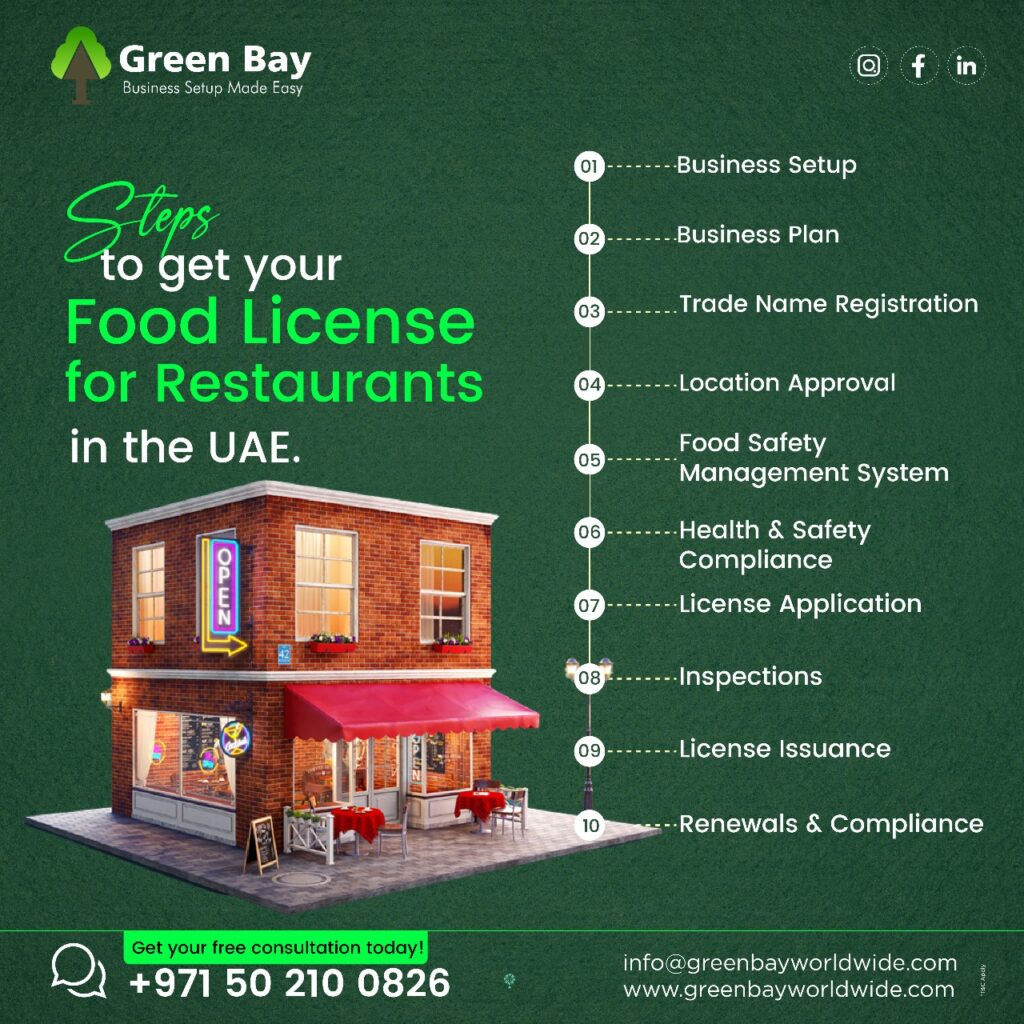
Close
Obtaining a food license for a restaurant in the United Arab Emirates (UAE) involves several steps and compliance with the regulations set by the local authorities. The specific process may vary slightly depending on the emirate where you plan to operate your restaurant. Generally, the process involves the following steps:
Choose a legal structure for your restaurant, such as a sole proprietorship, LLC, or branch of a foreign company.
Register your business with the Department of Economic Development (DED) or the relevant authority in the emirate.
Create a comprehensive business plan outlining your concept, target market, competition, and financial projections.
Getting a suitable location for a food restaurant in the United Arab Emirates (UAE) involves several steps, and the process can vary based on the emirate where you plan to operate. Here is a general guide to help you secure a location for your restaurant:
Market Research: Conduct thorough market research to understand the target audience, competition, and demand in the area where you intend to open your restaurant.
Define Your Concept: Clearly define the concept and theme of your restaurant. This will help you identify the type of location that suits your business, such as a busy commercial area, a trendy neighbourhood, or a shopping mall.
Budget Planning: Determine your budget for the lease or purchase of the restaurant location. Consider not only the rental or purchase cost but also additional expenses such as fit-out costs and utility deposits.
Engage a Real Estate Agent: Consider hiring a local real estate agent or consultant who is familiar with the market and can help you find suitable locations based on your requirements.
Zoning Regulations: Understand the zoning regulations in the specific emirate where you plan to open your restaurant. Different zones may have restrictions on the type of businesses allowed, so it’s important to ensure that your restaurant is compliant.
Approval from Authorities: Obtain approval from the relevant authorities, such as the municipality or zoning department, for your chosen location. This may involve submitting your business plan, concept details, and obtaining location clearance.
Check Accessibility: Ensure that the location is easily accessible to your target customers. Consider factors such as parking availability, public transportation access, and overall convenience.
Negotiate Lease Terms: Negotiate lease terms with the property owner or landlord. Be clear on the lease duration, rental costs, and any additional charges. Seek legal advice if needed before signing any agreements.
Legal Documentation: Prepare and complete all legal documentation required for leasing or purchasing the property. This may include obtaining a No Objection Certificate (NOC) from the landlord, submitting a tenancy contract, and fulfilling any other legal requirements. its very important part on food license for restaurant.
Fit-Out and Renovations: Plan the interior design and layout of your restaurant. Obtain necessary approvals for any fit-out or renovation work from the municipality or relevant authorities.
Sign the Lease Agreement: Once all approvals are in place and the terms have been negotiated, sign the lease agreement with the property owner. Ensure that all details are clearly outlined in the contract.
Utilities and Services: Arrange for utility connections such as water, electricity, and gas. Check with local authorities for any specific requirements or permits related to these services.
Opening Procedures: Complete any remaining administrative and legal procedures before officially opening your restaurant. This may include obtaining a food license for restaurant, health and safety approvals, and other necessary permits.

In the UAE, food safety management is overseen by several authorities, with the key one being the Abu Dhabi Food Control Authority (ADFCA) and the Dubai Municipality. The food safety management system in the UAE is designed to ensure that food businesses operate in compliance with food safety regulations to protect public health. Here are the key components:
Regulations and Standards: The UAE follows strict regulations and standards based on HACCP (Hazard Analysis and Critical Control Points) principles to ensure food safety. These regulations cover food handling, storage, preparation, and transportation.
Licensing and Inspection: Food businesses must obtain the necessary licenses from the local municipalities. Regular inspections are conducted to ensure compliance with food safety standards.
Food Handling and Hygiene: Food handlers are required to undergo training in food safety and hygiene practices. This includes proper handwashing, personal hygiene, and safe food handling procedures.
Temperature Control: Food establishments must adhere to strict temperature control measures for food storage and preparation to prevent bacterial growth and foodborne illnesses.
Traceability and Labelling: There are strict guidelines for food labelling and traceability to ensure that consumers have access to accurate information about the food products they purchase.
Allergen Management: Food businesses are required to manage and declare allergens present in their food products, ensuring that consumers with allergies are informed.
Food Safety Management Systems (FSMS): Implementation of FSMS, such as ISO 22000, is encouraged to systematically manage food safety hazards and ensure compliance with regulatory requirements.
It’s important for food businesses in the UAE to stay updated with the latest regulations and guidelines to ensure ongoing compliance with food safety standards.
Ensuring health and safety compliance is essential for businesses operating in the United Arab Emirates (UAE). Compliance with health and safety regulations helps create a safe working environment for employees and protects the well-being of the public. Here are key aspects of health and safety compliance in the UAE:
Occupational Health and Safety Laws: The UAE has federal and emirate-specific laws and regulations related to occupational health and safety. Federal Law No. 8 of 1980, also known as the UAE Labor Law, includes provisions related to workplace safety.
Federal Authority for Government Human Resources (FAHR): FAHR plays a role in regulating and implementing health and safety policies for federal government employees in the UAE.
Emirate-Specific Regulations: Each emirate may have its own health and safety regulations and authorities. It’s important for businesses to be aware of and comply with emirate-specific requirements.
Workplace Risk Assessments: Conduct regular risk assessments to identify and address potential hazards in the workplace. This includes assessing physical, chemical, biological, and ergonomic risks.
Emergency Preparedness: Develop and implement emergency response plans, including evacuation procedures, first aid, and fire safety measures.
Ensure that employees are trained on emergency procedures.
Workplace Inspections: Expect periodic inspections by relevant authorities to ensure compliance with health and safety regulations.
Safety Training: Provide health and safety training to employees, covering topics such as safe work practices, use of personal protective equipment (PPE), and emergency response procedures.
Personal Protective Equipment (PPE): Ensure that employees have access to and use appropriate personal protective equipment based on the nature of their work.
Health and Medical Services: Provide access to necessary health and medical services for employees, including regular health check-ups and access to first aid.
Health and Safety Committees: Establish health and safety committees to involve employees in identifying and addressing workplace safety issues.
Accident Reporting and Investigation: Implement a system for reporting and investigating workplace accidents. This includes keeping records of incidents and taking corrective actions to prevent recurrence.
Work Hours and Rest Periods: Comply with regulations related to work hours, rest periods, and breaks to prevent employee fatigue and ensure overall well-being.
Health and Safety Manuals: Develop and maintain health and safety manuals that provide guidelines for employees on safety practices and procedures.
Health Checks and Vaccinations: Depending on the industry, ensure that employees undergo necessary health checks and vaccinations to prevent the spread of communicable diseases.
In the United Arab Emirates (UAE), the inspection of food restaurants is conducted by health authorities to ensure compliance with food safety regulations and standards. The process involves a thorough assessment of various aspects of the restaurant’s operations to verify that it meets the required hygiene and safety standards. Here’s a general overview of how the inspection of food restaurants works in the UAE:
Scheduled and Surprise Inspections: Health authorities in the UAE conduct both scheduled and surprise inspections. Scheduled inspections are usually planned in advance, while surprise inspections may occur without prior notice.
Inspection Criteria: The inspection covers a range of criteria, including hygiene practices, food storage, handling procedures, cleanliness, sanitation, pest control, kitchen facilities, equipment maintenance, and overall compliance with food safety regulations.
Document Verification: During the inspection, officials may verify the restaurant’s documents, including the food license, trade name registration, location approval, and any other relevant permits.
Food Safety Management System (FSMS): Inspectors assess whether the restaurant has implemented and is following a Food Safety Management System (FSMS) based on principles such as Hazard Analysis and Critical Control Points (HACCP). This includes checking if there are documented procedures for handling, preparing, and serving food safely.
Hygiene and Sanitation: The inspection evaluates the cleanliness and sanitation of the premises, kitchen, dining areas, and restrooms. This includes checking for proper waste disposal, clean food contact surfaces, and adequate handwashing facilities.
Food Handling Practices: Inspectors observe food handling practices to ensure that employees follow proper hygiene standards. This involves checking if staff members are using appropriate personal protective equipment (PPE) and maintaining good personal hygiene.
Temperature Control: Temperature control is crucial to prevent foodborne illnesses. Inspectors check if the restaurant is storing, cooking, and serving food at safe temperatures. This includes checking refrigeration units, hot holding equipment, and food warming practices.
Pest Control: Inspectors assess the measures in place to control pests, including the use of pest control services, proper waste management, and sealing potential entry points.
Menu Compliance: The menu is reviewed to ensure that it aligns with the food license and complies with regulations. This includes verifying that the restaurant is not serving prohibited or unsafe foods.
Corrective Actions and Follow-Up: If violations or non-compliance are identified during the inspection, the restaurant may be required to take corrective actions. Follow-up inspections may be scheduled to ensure that necessary improvements have been made.
Reporting and Compliance Certificates: The health authority issues a report detailing the findings of the inspection. If the restaurant is found to be in compliance, a compliance certificate may be issued. Non-compliance may result in penalties, warnings, or closure if serious violations are identified.
Obtaining food license for restaurant may seem daunting, but with proper planning and preparation, it becomes a crucial step in building a successful and responsible restaurant. It is important to note that the process may vary slightly between emirates. Therefore, it is advisable to check with the local authorities in the specific emirate where you plan to open your restaurant for the most accurate and up-to-date information. Consulting with a business advisor or legal professional familiar with UAE regulations can also be helpful in navigating the licensing process.